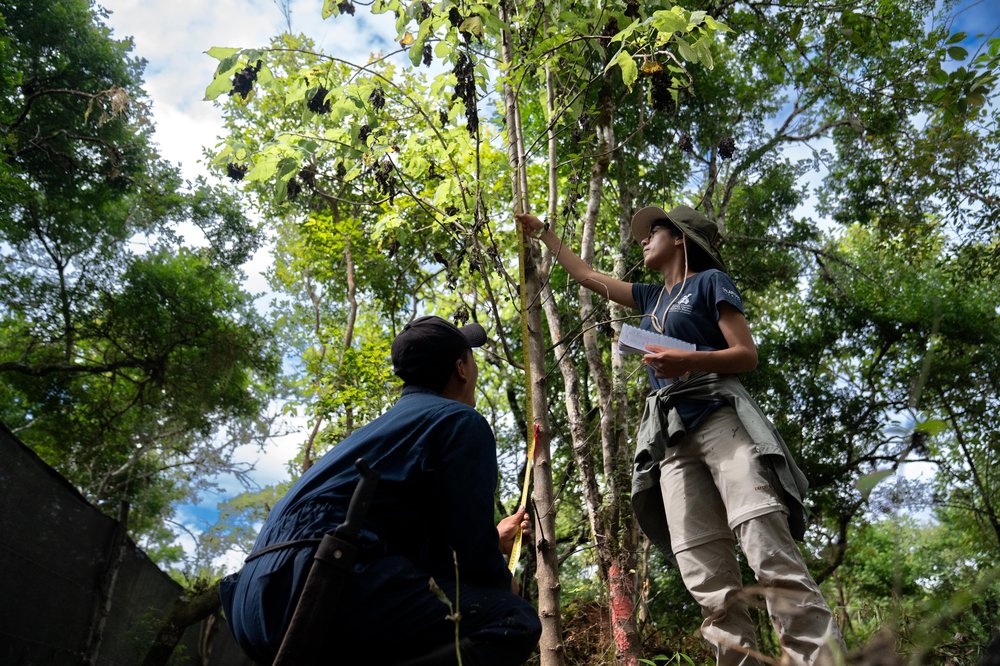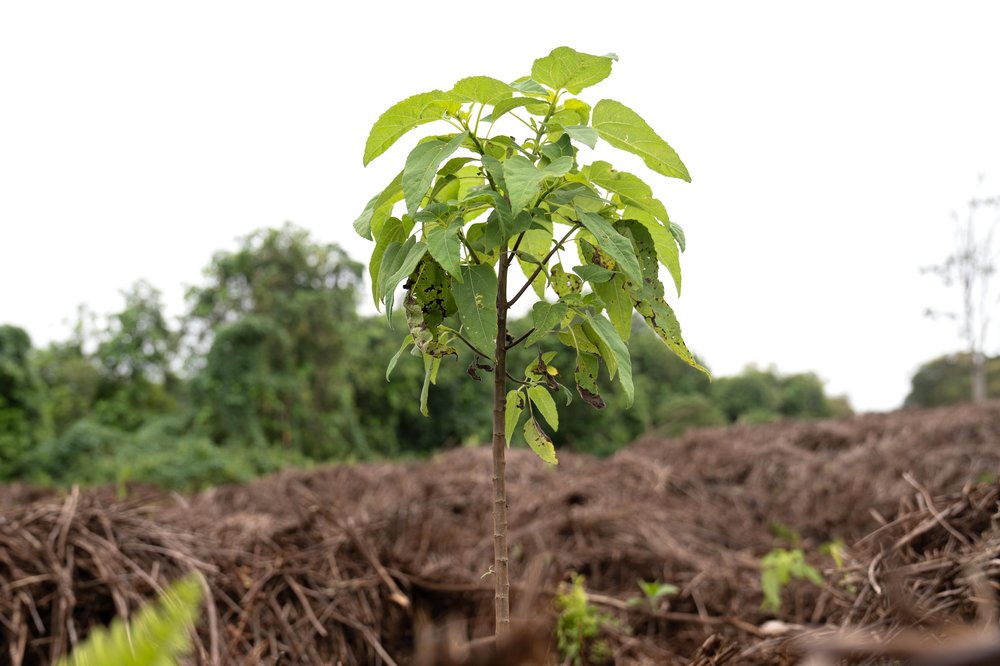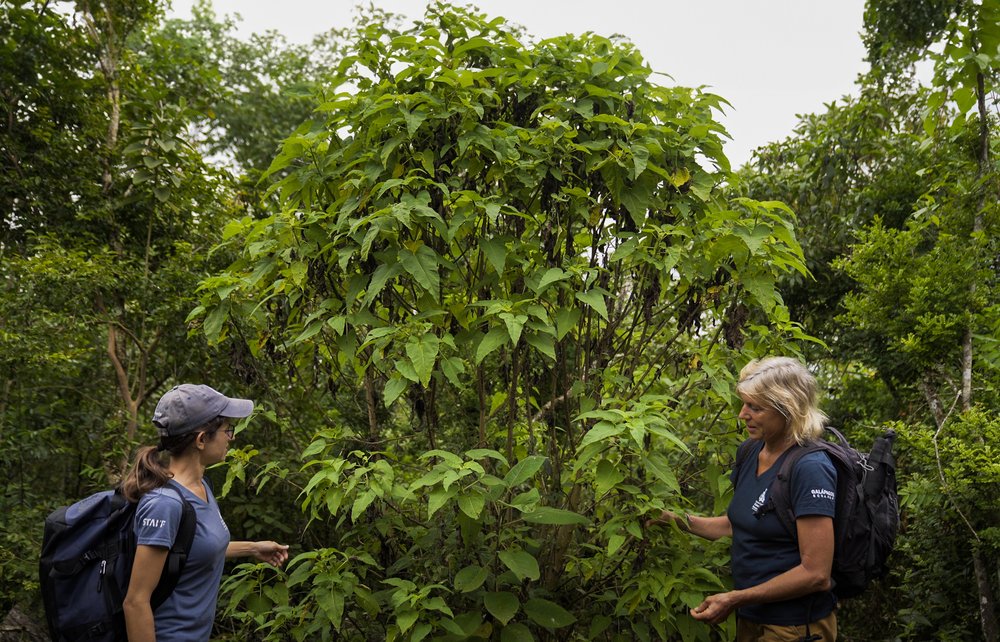New Populations of Scalesia cordata Found in Southern Isabela Island, Galapagos
Puerto Ayora, September 16, 2024 – Park rangers from the Galapagos National Park Directorate (GNPD), in collaboration with scientists from the Charles Darwin Foundation (CDF), have discovered two new areas of Scalesia cordata on Sierra Negra volcano, located in southern Isabela Island. This discovery marks a significant milestone in the ongoing efforts to preserve this critically endangered species, which has seen its natural habitat severely reduced.
The larger of the two areas, named "Carpuela," spans 2 hectares and is home to 43 adult trees, 102 juveniles, and 17 seedlings, all in good health. This discovery is significant, as Scalesia cordata has faced a dramatic decline in population in recent years. Following the discovery, the GNPD and CDF immediately implemented protective measures, including the removal of invasive plant species and ongoing monitoring to encourage the species' natural regeneration.
Heinke Jäger, leader of the Restoration Project at the CDF, said: “Finding more and more Scalesia cordata trees gives us great hope that we can save this species from extinction. When we started this project in 2021, we believed there were only 300 trees left on Isabela. Today, thanks to our joint efforts, we have increased the population to over 3,000, but there is still much work ahead. Scalesia cordata is an endemic species to Isabela that supports a unique biodiversity, including the vermilion flycatcher, several species of finches, and hundreds of insects and plants that depend on this ecosystem for survival.”
A second, smaller remnant of Scalesia cordata was found in a nearby area, covering approximately 40 square meters, consisting of just four adult trees. Similar protective and monitoring efforts are underway to safeguard this population as well.
The value of Scalesia in Galapagos ecosystems
Scalesia is a plant genus found only in the Galapagos Islands, with 15 species varying by island and climate zone. These species are vital to the archipelago’s ecosystems, as they provide habitat for many endemic species of birds, insects, and plants. The Scalesia species are considered the plant equivalent of Darwin's finches and the giant tortoises, having evolved in distinct forms and adapted to different environments. Sadly, Scalesia cordata, named for the heart-shaped leaves and found nowhere else in the world but the slopes of Isabela’s southern volcanoes, has been severely impacted by habitat degradation, particularly on the Cerro Azul and Sierra Negra volcanoes.
A 2002 study by the CDF and GNPD estimated around 1,075 Scalesia cordata trees. Yet by 2019, less than 3% of that population was estimated to remain, with a concerning absence of young trees, raising alarms about the species' potential extinction.
“The situation with Scalesia cordata is alarming. It’s heartbreaking to walk for hours and find only a few scattered trees and no seedlings. We still have populations where natural regeneration hasn’t occurred. But discovering new populations motivates us to continue our restoration efforts with even more determination,” said Miriam San José, a researcher at the CDF.


Conservation and restoration efforts
In response to this crisis, the CDF, in collaboration with the GNPD and with financial support from Fondation Franklinia and the Keidanren Nature Conservation Fund (KNCF), in 2021 launched an ambitious restoration program for Scalesia cordata. Galapagos Conservancy and the IOI Foundation joined the program in 2023. The program focuses on collecting seeds, growing them in forest nurseries, reintroducing them into areas where the species was once abundant, and searching for new populations on foot and with drones. Thanks to these efforts, over 3,000 individuals, including seedlings, juveniles, and adult trees, now thrive across approximately 637 hectares, spanning protected areas and agricultural lands.
“The success of this restoration program is a testament to the positive impact we can achieve when we collaborate to protect endangered species,” emphasized Arturo Izurieta, Director of the Galapagos National Park.
The Role of Technology in Conservation
Drone monitoring and field studies led by the CDF have been crucial in locating new populations of Scalesia cordata, as well as collecting ecological data to support its long-term protection. These efforts represent a major step forward in conserving one of the archipelago’s most threatened endemic plant species and stand as a testament to the CDF’s commitment to preserving the unique ecosystems of the Galapagos.
For media enquiries, please contact:
Charles Darwin Foundation
Ambre Tanty-Lamothe or Leslie León
comunicacion@fcdarwin.org.ec
Galapagos National Park Directorate
Rosa León, Communications Director
rleon@galapagos.gob.ec | +593 96 985 4231
About the Charles Darwin Foundation
The Charles Darwin Foundation for the Galapagos Islands (CDF) is an international nonprofit organization present in Galapagos since 1959, operating under a special agreement with the Government of Ecuador. Its mission, and that of its Research Station, is to address the greatest threats and challenges facing Galapagos through scientific research and conservation actions, with the goal of protecting one of the world’s most important natural treasures. Currently, CDF carries out more than 25 research and conservation projects and is the custodian of more than 135,000 specimens within its Natural History Collections. Our diverse team of more than 140 people is predominantly composed of Ecuadorian citizens, with over 60% being residents hailing from the Galapagos Islands. For more information, visit: www.darwinfoundation.org
About the Galapagos National Park Directorate
The Galápagos National Park Directorate is the Ecuadorian government entity responsible for the protection, conservation, and management of the natural resources within the terrestrial and marine protected areas of the Galapagos Islands and their surrounding marine environment. Its mission is to preserve the unique ecosystems and biodiversity of this archipelago, which has been declared a UNESCO World Heritage Site and Biosphere Reserve, through the implementation of conservation regulations and strategies. Additionally, it oversees tourism and scientific activities, ensuring they are conducted sustainably and without compromising the integrity of the ecosystems. For more information, visit: www.galapagos.gob.ec






